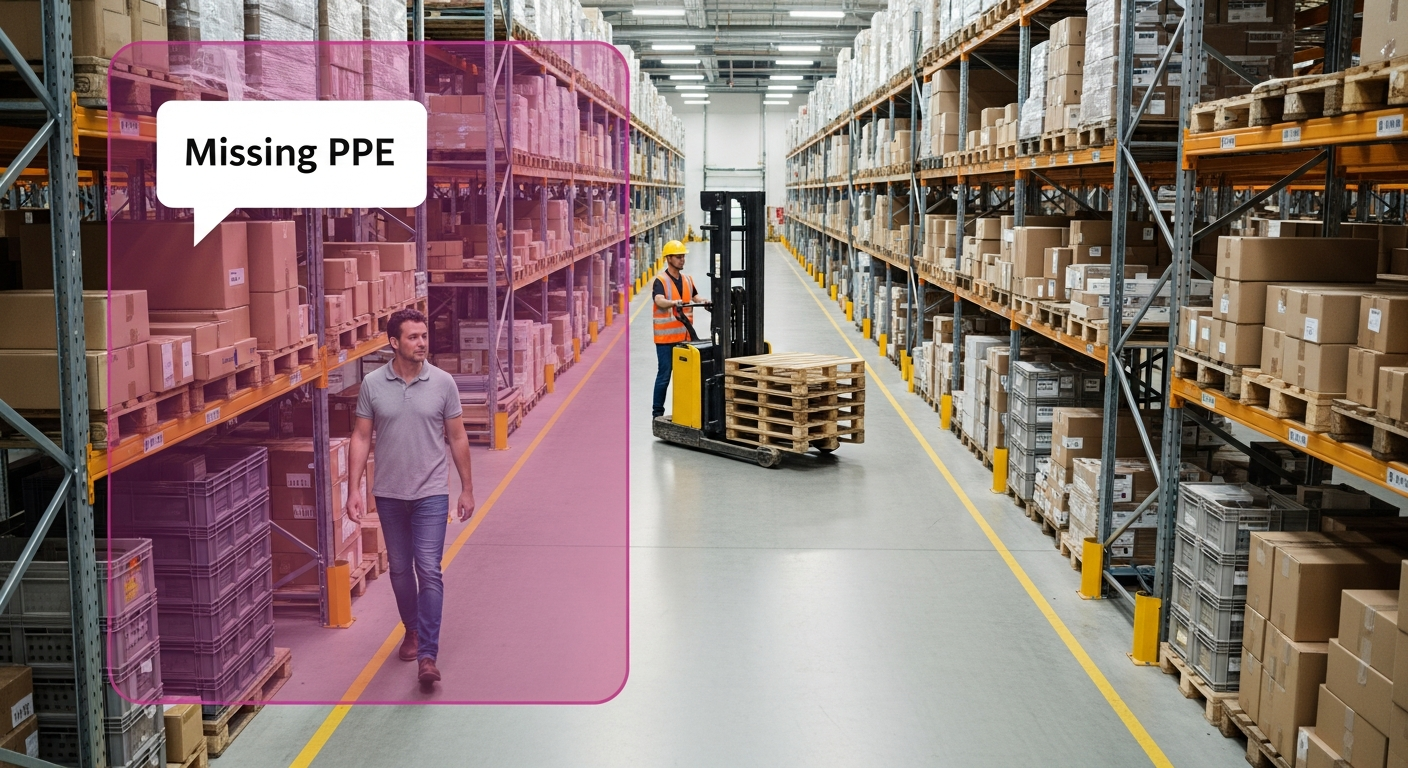Warehousing remains one of the most dangerous industries in the U.S., with non-fatal injuries occurring at a rate of 3.7 per 100 full-time workers—almost 30% higher than the private industry average (Source: U.S. Bureau of Labor Statistics). Forklift accidents, and struck-by incidents continue to drive these numbers, leading to thousands of workers sidelined every year and millions lost to direct and indirect costs (Source: Herc-U-Lift). The good news? The likelihood of most of these injuries can be substantially reduced. With the right safety protocols—and smarter use of technology, like video AI—warehouses can cut risk, boost compliance, and protect their people.
In this guide, we’ll break down the top 3 injuries that happen most in warehousing—and show how a practical, tech-supported approach can help you mitigate them. We’ll cover real-world risks, proven controls, and the crucial role video intelligence now plays in creating safer, more accountable workplaces.
The top 3 warehouse injuries (and how technology can help mitigate them)
Warehousing workflows are fast-moving, complex, and filled with potential hazards. But three injury types consistently top the list—each with clear mitigation paths, and each directly addressable by video intelligence.
1. Forklift and Vehicle Collisions
Collisions often happen at blind aisle corners when a forklift and a pedestrian cross paths unexpectedly. These forklift-related incidents cause between 35,000 and 62,000 injuries annually in the U.S., including about 87 fatalities (Source: Herc-U-Lift).
The impact: Beyond fractures and crushing injuries, vehicle-related incidents can lead to major direct and indirect costs, including medical expenses, lost productivity, and equipment damage.
How video intelligence helps: Video AI platforms with AI Agents can monitor intersections, proactively alert teams when pedestrians enter vehicle-only zones, and provide swift video evidence for post-incident analysis.
2. Struck-by Moving Objects
Struck-by incidents occur when an object, such as a falling pallet from a high rack or a box from a conveyor, hits a worker. These events are a serious hazard in warehousing and can lead to fatalities.
The impact: Struck-by injuries often mean fractures, head trauma, or even fatalities. These are not “freak accidents”—they’re foreseeable and mitigable.
How video intelligence helps: Video AI Agents can detect unsafe access to high-rack areas and trigger alerts when safety barriers are breached, assisting teams in preemptively reducing the risk of struck-by incidents.
3. Caught-in or Crushed by Machinery
Caught-in or crushed injuries can happen when a worker interacts with machinery without following lockout/tagout procedures, leading to unexpected equipment activation. These injuries represent 13.4% of warehouse incidents, with 10.3% of those resulting in amputations (Source: OSHA).
The impact: These injuries are severe and often permanent. The cost—in lives and dollars—is substantial.
How video intelligence helps: Video AI can be configured to verify that machine guards are in place, send alerts in real time for unauthorized access to equipment during maintenance, and deliver video evidence without delay for root-cause investigations.
Challenges and impact of the injuries
These top risks create distinct challenges on the warehouse floor, where data and technology can support mitigation.
Practical implementation of safety technology
A practical rollout ensures that safety technology supports your operations instead of complicating them. Key steps include:
- Integrate with what you have. Video AI platforms like Spot AI work with most existing camera infrastructure, so you don’t have to rip and replace.
- Focus on high-risk zones first. Start with loading docks, aisle intersections, and at-height picking areas—where the data shows most injuries occur.
- Align with your safety goals. Use tech to support (not replace) your existing training, incident reporting, and audit processes. Use video to bolster your existing safety program.
- Involve frontline workers. Make sure everyone understands how technology enhances safety and respects privacy. Use it to empower and coach your team.
- Evaluate for your needs. Choose solutions that offer real-time alerts, easy video search, and compliance reporting tailored to warehousing. Look for platforms that are simple, open, and help you address your biggest safety priorities without adding IT overhead.
Safety technology is only as strong as the people and processes behind it. The best results come from combining proven protocols with smarter, faster visibility.
Take charge of warehouse safety: partner for better outcomes
Effective warehousing safety protects your people, uptime, and reputation while ensuring compliance. You have powerful new tools to manage your known risks faster and more effectively.
Curious how video AI can help you reduce warehouse risks? Request a live demo to see Spot AI in action and explore how video intelligence supports safer, more efficient operations.
Frequently asked questions
What are the most common injuries in warehousing?
The most common injuries are forklift and vehicle collisions, struck-by moving objects, and caught-in/crushed by machinery. These account for the majority of severe incidents and can be markedly reduced through a mix of strong protocols, training, and video intelligence.
How can video AI help reduce forklift accidents?
Video AI monitors key risk zones like aisle intersections and pedestrian crossings. AI Agents can alert supervisors in real time if a pedestrian or vehicle enters a restricted no-go zone, helping to reduce the risk of collisions.
What’s the best way to integrate safety technology with my current systems?
Choose video analytics platforms that work with your existing camera infrastructure and safety processes. Look for solutions with open, easy integration, real-time alerts, and simple search capabilities. Involve your IT and safety teams early to ensure a smooth rollout.
Are there compliance requirements for video monitoring in warehouses?
Yes. OSHA requires safety monitoring, incident documentation, and regular hazard assessments. Video AI systems aid in documenting compliance, support incident investigations, and verify that protocols like lockout/tagout and PPE use are being followed (Source: OSHA 1910.178).
How to ensure my team buys into new safety technology?
Involve frontline workers in the rollout, clearly explain how the technology supports their safety, and use it to empower them to report hazards. Respect privacy and use video as a tool for positive change, not for disciplinary oversight.
How do video AI analytics support incident investigations?
AI-powered video makes it fast and easy to find the exact footage of an incident. This assists in clarifying root causes, verifying protocol compliance, and training staff on what went wrong and how to reduce the likelihood of it happening again.
What is the best video analytics for workplace safety?
The best video analytics for workplace safety is practical, scalable, and easy for your teams to use. Look for a platform that works with your existing cameras, sends real-time alerts for timely hazard response, and offers intelligent search to find incident footage in seconds. The right system enables you to spot systemic risks across all sites without creating a heavy strain for your IT team.
About the author
Joshua Foster is an IT Systems Engineer at Spot AI, where he focuses on designing and securing scalable enterprise networks, managing cloud-integrated infrastructure, and automating system workflows to enhance operational efficiency. He is passionate about cross-functional collaboration and takes pride in delivering robust technical solutions that empower both the Spot AI team and its customers.

























.png)
.png)
.png)